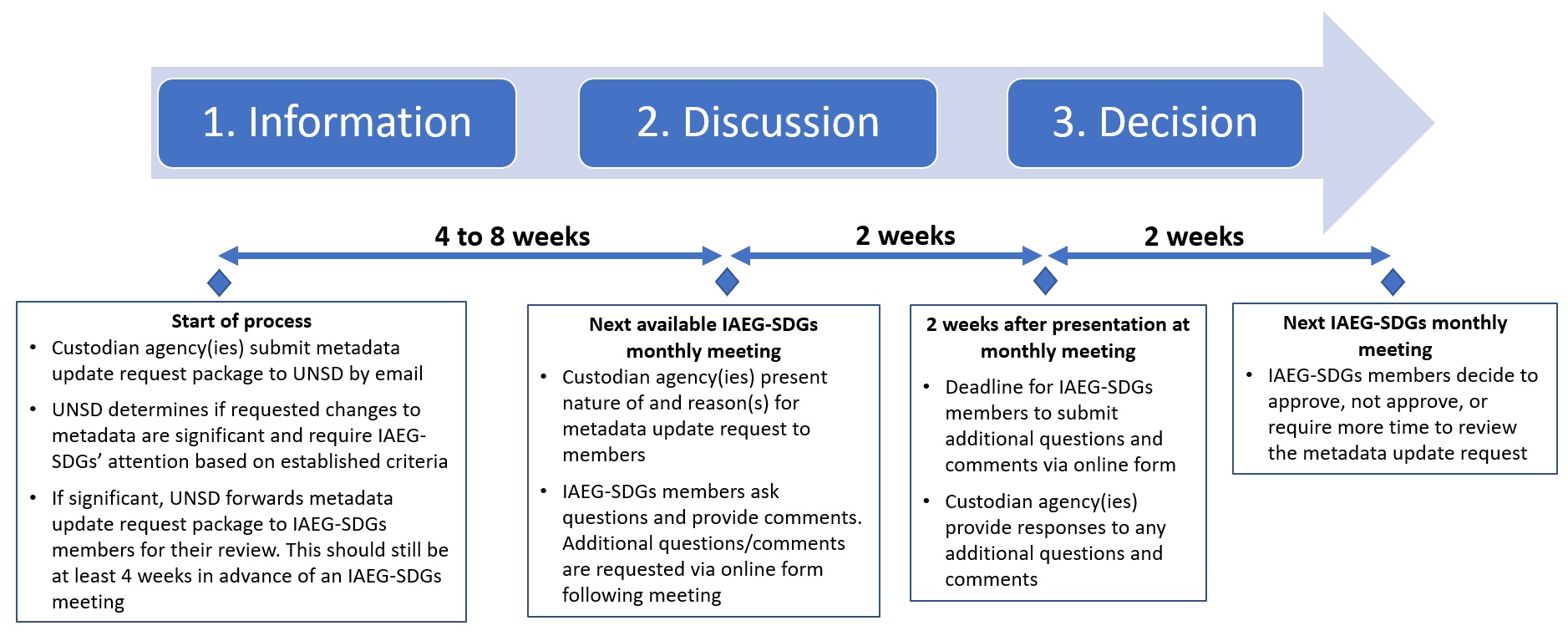SDG Indicators
Metadata repository
The metadata available in this repository is a work in progress. It reflects the latest reference metadata information provided by the UN System and other international organizations on data and statistics for the Tier I and II indicators in the global indicator framework. This repository will be further updated and periodically reviewed in cooperation with the respective data compilers.
In addition:
- Official list of Global Sustainable Development Goal indicators
- Tier Classification for Global SDG Indicators
- Previous Work Plans for Tier III Indicators (archive)
- Metadata for initially proposed indicators (archive)
Metadata update process:
Methodology for indicators is expected to update from time to time. For any metadata updates that include significant changes (detailed in the form below), the IAEG-SDGs will review the changes during its member meetings based on the update request form (see below) and track change metadata provided. Custodian agencies will also be invited to attend an upcoming IAEG-SDG member meeting to present on the proposed changes and answer any questions.
As requested by the IAEG-SDGs, custodian agencies must provide their metadata update request documents at least one month in advance of their next scheduled meeting to allow for sufficient time for review. Depending on the time of submission and the next IAEG-SDG member meeting, the timeline for review and approval can span up to 12 weeks or more. Therefore, it is important to provide submissions as soon as they are available. Please note that no data are published in the Global SDG Indicators Database until the corresponding metadata is approved by the IAEG-SDGs.
Please see below the projected stages and timeline.
To get started, custodian agencies are requested to:
- Download the metadata Word file for the indicator from the metadata repository (below) and edit the Word file in track changes to show the requested changes.
- Custodian agency downloads and completes the “Metadata update request form” (below) and sends the request package to sdgindicators@un.org.
Search
Goal 10. Reduce inequality within and among countries
Target 10.1: By 2030, progressively achieve and sustain income growth of the bottom 40 per cent of the population at a rate higher than the national average
- Indicator 10.1.1: Growth rates of household expenditure or income per capita among the bottom 40 per cent of the population and the total population
Target 10.2: By 2030, empower and promote the social, economic and political inclusion of all, irrespective of age, sex, disability, race, ethnicity, origin, religion or economic or other status
- Indicator 10.2.1: Proportion of people living below 50 per cent of median income, by sex, age and persons with disabilities
Target 10.3: Ensure equal opportunity and reduce inequalities of outcome, including by eliminating discriminatory laws, policies and practices and promoting appropriate legislation, policies and action in this regard
- Indicator 10.3.1: Proportion of population reporting having personally felt discriminated against or harassed in the previous 12 months on the basis of a ground of discrimination prohibited under international human rights law
Target 10.4: Adopt policies, especially fiscal, wage and social protection policies, and progressively achieve greater equality
- Indicator 10.4.1: Labour share of GDP
- Indicator 10.4.2: Redistributive impact of fiscal policy on the Gini index
Target 10.5: Improve the regulation and monitoring of global financial markets and institutions and strengthen the implementation of such regulations
Target 10.6: Ensure enhanced representation and voice for developing countries in decision-making in global international economic and financial institutions in order to deliver more effective, credible, accountable and legitimate institutions
- Indicator 10.6.1: Proportion of members and voting rights of developing countries in international organizations
Target 10.7: Facilitate orderly, safe, regular and responsible migration and mobility of people, including through the implementation of planned and well-managed migration policies
- Indicator 10.7.1: Recruitment cost borne by employee as a proportion of monthly income earned in country of destination
- Indicator 10.7.2: Proportion of countries with migration policies that facilitate orderly, safe, regular and responsible migration and mobility of people
- Indicator 10.7.3: Number of people who died or disappeared in the process of migration towards an international destination
- Indicator 10.7.4: Proportion of the population who are refugees, by country of origin
Target 10.a: Implement the principle of special and differential treatment for developing countries, in particular least developed countries, in accordance with World Trade Organization agreements
- Indicator 10.a.1: Proportion of tariff lines applied to imports from least developed countries and developing countries with zero-tariff
Target 10.b: Encourage official development assistance and financial flows, including foreign direct investment, to States where the need is greatest, in particular least developed countries, African countries, small island developing States and landlocked developing countries, in accordance with their national plans and programmes
- Indicator 10.b.1: Total resource flows for development (e.g. official development assistance, foreign direct investment and other flows)
